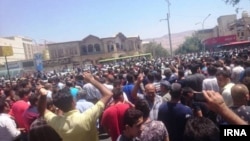Amnesty International (AI) has called on Iran to release peaceful protesters following a wave of arrests over demonstrations against the Islamic Republic’s dire economic conditions and its foreign military interventions.
The world’s leading human-rights organization also urged the authorities to conduct a “prompt, impartial and independent” investigation into the killing of a protester in Karaj, north-west of Tehran, on Aug. 3.
In its latest statement on Iran, London based AI has referred to recent protests rallies in a Karaj, 42 km (26 mi) west of the capital city, Tehran, noting, “Among those detained and at risk of torture and other ill-treatment is human rights defender Nader Afshari, who was arrested by Ministry of Intelligence officials on 1 August 2018 in the city of Karaj, and whose whereabouts are unknown as he is being held in a secret detention facility.”
Nader Afshari was arrested last winter, but later released on a one-billion rial (roughly $21,000) bail. Nevertheless, he was detained again and his mother, Maryam Sabzparvar, told Radio Farda at the time that she was unaware of the whereabouts of her son.
Referring to “the authorities’ track record in recent months of torturing and otherwise ill-treating detainees, as well as reports of deaths in custody,” AI has expressed its “fears for the well-being of Nader Afshari and other detainees.”
Protests over the tough economic situation, financial corruption and mismanagement in Iran broke out last December in city of Mashhad, northeastern Iran and soon spread to more than hundred cities and towns across the country, leaving at least 25 dead.
The ongoing widespread demonstrations in Iran resurfaced past week, with a fresh wave of protests beginning in the city of Esfahan, central Iran, on July 31, AI has noted, adding, “The protests quickly spread to other cities across much of the country, including Karaj, Rasht and Tehran in the north; Mashhad in the north-east; Arak, Ahvaz and Kermanshah in the west; and Shiraz and Kazeroun in the south.”
According AI, “Since July 31, thousands of people have taken to the streets to voice their grievances over increasing economic hardship in Iran caused in part by high inflation and the steep devaluation of the national currency, rial. However, in now familiar scenes, dozens of videos that have been shared on social media also show protesters chanting slogans opposing authoritarianism, the political establishment and, specifically, Iran’s Supreme Leader.”
Citing reports filed by state-run news outlets in Iran, AI has affirmed, “Most of the demonstrations appear to have been peaceful, but, in some instances, protesters have engaged in acts of violence, including stone-throwing, arson and other damage to vehicles and buildings. According to Tasnim News Agency, which is affiliated with the Revolutionary Guards Corps, on 3 August 2018, a group of individuals attacked a religious school in the district of Eshtehard in Alborz province, breaking some of its windows with stones and bricks.”
However, AI has immediately pointed out, “Reports and videos on social media have also shown the use of unnecessary and excessive force by security forces to disperse demonstrations.”
Furthermore, AI has lambasted the Islamic Republic authorities for ill-treatment of the the detainees, specifically female inmates.
“According to reports on social media, fifty women who were protesting have been taken to Shahr-e Rey prison in Varamin, outside Tehran. Shahr-e Rey prison (also known as Gharchak) is a disused chicken farm that holds several hundred women convicted of violent offenses in overcrowded and unhygienic conditions, without access to safe drinking water, decent food, medicine or fresh air. Reports from the facility indicate the proliferation of infectious diseases, rampant drug use and high levels of violence by prison staff on detainees and between inmates.”
In its statement AI has also raised its concern over the case of 26-year old protester, Reza Outadi, who was killed in Karaj, north-west of Tehran, on 3 August 2018.
Two days later, AI has reported, the Prosecutor General of Karaj announced that Outadi had been “killed by gunfire that came from protesters amidst the rioting that took place” in Karaj. He said that Reza Outadi was “shot in the back and killed”.
According to a report from Fars News on 7 August 2018, the Prosecutor General of Karaj has since announced that a special unit has been set up to investigate Reza Outadi’s death. It includes a special group of weapons experts, the investigative arm of the police force, intelligence units of both the police and IRGC, and the Legal Medicine Organization of Iran (a state forensic institute).
“According to initial reports, the authorities only allowed Reza Outadi’s sister to view his body in order to confirm his identity. They told the family that they considered him to be a ‘rioter’ (shooreshi) and consequently would not be releasing his body to them. The authorities have since released his body to his family, who were able to hold his funeral on 6 August 2018 under heavy security presence” AI has reported.





